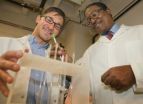(Press-News.org) A team of researchers from North Carolina State University and the U.K. has found that the low rate of energy conversion in all-polymer solar-cell technology is caused by the structure of the solar cells themselves. They hope that their findings will lead to the creation of more efficient solar cells.
Polymeric solar cells are made of thin layers of interpenetrating structures from two different conducting plastics and are increasingly popular because they are both potentially cheaper to make than those currently in use and can be "painted" or printed onto a variety of surfaces, including flexible films made from the same material as most soda bottles. However, these solar cells aren't yet cost-effective to make because they only have a power conversion rate of about three percent, as opposed to the 15 to 20 percent rate in existing solar technology.
"Solar cells have to be simultaneously thick enough to absorb photons from the sun, but have structures small enough for that captured energy – known as an exciton – to be able to travel to the site of charge separation and conversion into the electricity that we use," says Dr. Harald Ade, professor of physics and one of the authors of a paper describing the research. "The solar cells capture the photons, but the exciton has too far to travel, the interface between the two different plastics used is too rough for efficient charge separation, and its energy gets lost."
The researchers' results appear online in Advanced Functional Materials and Nano Letters.
In order for the solar cell to be most efficient, Ade says, the layer that absorbs the photons should be around 150-200 nanometers thick. (A nanometer is thousands of times smaller than the width of a human hair.) The resulting exciton, however, should only have to travel a distance of 10 nanometers before charge separation. The way that polymeric solar cells are currently structured impedes this process.
Ade continues, "In the all-polymer system investigated, the minimum distance that the exciton must travel is 80 nanometers, the size of the structures formed inside the thin film. Additionally, the way devices are currently manufactured, the interface between the structures isn't sharply defined, which means that the excitons, or charges, get trapped. New fabrication methods that provide smaller structures and sharper interfaces need to be found."
Ade and his team plan to look at different types of polymer-based solar cells to see if their low efficiencies are due to this same structural problem. They hope that their data will lead chemists and manufacturers to explore different ways of putting these cells together to increase efficiency.
"Now that we know why the existing technology doesn't work as well as it could, our next steps will be in looking at physical and chemical processes that will correct for those problems. Once we get a baseline of efficiency, we can redirect research and manufacturing efforts."
INFORMATION:
The research was funded by a grant by the U.S. Department of Energy and the Engineering and Physical Sciences Research Council, U.K. The Department of Physics is part of NC State's College of Physical and Mathematical Sciences.
Structure of plastic solar cells impedes their efficiency
2010-10-08
ELSE PRESS RELEASES FROM THIS DATE:
Stanford-led study disproves link between genetic variant, risk of coronary artery disease
2010-10-08
STANFORD, Calif. — A genetic marker touted as a predictor of coronary artery disease is no such thing, according to a study led by researchers at the Stanford University School of Medicine.
The massive international study, published online Oct. 7 in the Journal of the American College of Cardiology, assessed the predictive value of a leading genetic assay for risk of atherosclerosis.
The study analyzed the data from more than 17,000 patients with cardiovascular disease and 40,000 others to assess whether carrying a particular variant of the KIF6 gene indicated a greater ...
New tool in the fight against tuberculosis
2010-10-08
Researchers at the Institute for Genomic Biology at the University of Illinois have developed a way to harness the prodigious quantities of both genomic and metabolic data being generated with high-throughput genomics and other techniques. They have developed an algorithm that automatically integrates both data sets. The model, called probabilistic regulation of metabolism (PROM), enables researchers to perturb a given regulatory gene or metabolic process and see how that affects the entire network.
"PROM provides a platform for studying the behavior of networks in a ...
Thoughts about time inspire people to socialize
2010-10-08
Does thinking about time or money make you happier? A new study published in Psychological Science, a journal of the Association for Psychological Science, finds that people who are made to think about time plan to spend more of their time with the people in their lives while people who think about money fill their schedules with work, work, and—you guessed it—more work.
To find out how thinking about time or money makes people feel, Cassie Mogilner of the University of Pennsylvania designed an experiment, carried out online with adults from all over the United States, ...
Brown University chemists simplify biodiesel conversion
2010-10-08
PROVIDENCE, R.I. [Brown University] — As the United States seeks to lessen its reliance on foreign oil, biodiesel is expected to play a role. According to the National Renewable Energy Laboratory, a branch of the Department of Energy, biodiesel "represents a significant energy resource and could someday supply 3 percent to 5 percent of the distillate fuel market."
One major obstacle to achieving that goal is figuring how to efficiently convert the abundant stocks of waste vegetable oil (oil used after cooking French fries, for example) into biodiesel fuel. Current techniques ...
Melanoma uses body's immune system to spread to lungs
2010-10-08
The way melanoma cells use the immune system to spread and develop into lung tumors may lead to a therapy to decrease development of these tumors, according to Penn State researchers.
"Melanoma is the most aggressive and metastatic form of skin cancer," said Gavin Robertson, professor of pharmacology, pathology, dermatology and surgery in the Penn State College of Medicine. "Therefore, identifying proteins and molecular mechanisms that regulate metastasis is important for developing drugs to treat this disease."
Metastasis is a complex process in which cancer cells ...
MIT researchers develop a better way to see molecules at work in living brain cells
2010-10-08
CAMBRIDGE, Mass. -- By creating a better way to see molecules at work in living brain cells, researchers affiliated with MIT's Picower Institute for Learning and Memory and the MIT Department of Chemistry are helping elucidate molecular mechanisms of synapse formation. These studies could also help further understanding of how synapses go awry in developmental diseases such as autism and Fragile X syndrome. The study will appear in the Oct. 7 issue of Cell.
Using the new technique, which is more accurate and sensitive than existing methods, the researchers found that ...
US invested $139 billion in health research in 2009
2010-10-08
WASHINGTON—October 7, 2010—The U.S. invested $139 billion last year in health research from all public and private sources, according to Research!America's latest annual estimate. That amount represents only 5.6% of the $2.47 trillion overall U.S. health spending in 2009—or 5.6¢ of every health dollar—which varies no more than 0.2% from 2005 levels.
The estimate is available here: http://www.researchamerica.org/uploads/healthdollar09.pdf.
The 2009 investment grew by only 0.1% over 2008. This small increase can be attributed largely to the federal stimulus funding ...
NASA satellites see Otto become a tropical storm
2010-10-08
NASA satellites have collected data as the Atlantic Ocean's Tropical Depression 17 has undergone two changes in less than 24 hours. Since Oct. 6, the depression has strengthened and has tropical storm-force winds and has morphed from a sub-tropical storm into a tropical storm.
After a United States Air Force Reserve reconnaissance flight subtropical depression seventeen was upgraded by the National Hurricane Center (NHC) to subtropical storm Otto on Oct. 6 at 5 p.m. EDT (2100 UTC). On Oct. 6 and 7, NASA's TRMM and Aqua satellites were flying overhead measuring very cold, ...
Saturn's icy moon may keep oceans liquid with wobble
2010-10-08
Saturn's icy moon Enceladus should not be one of the most promising places in our solar system to look for extraterrestrial life. Instead, it should have frozen solid billions of years ago. Located in the frigid outer solar system, it's too far from the sun to have oceans of liquid water -- a necessary ingredient for known forms of life -- on its surface.
Some worlds, like Mars or Jupiter's moon Europa, give hints that they might harbor liquid water beneath their surfaces. Mars is about 4,200 miles across and Europa almost 2,000 miles across. However, with a diameter ...
3-way control of fetal heart-cell proliferation could help regenerate cardiac cells
2010-10-08
PHILADELPHIA - Heart muscle cells do not normally replicate in adult tissue, but multiply with abandoned during development. This is why the loss of heart muscle after a heart attack is so dire—you can't grow enough new heart muscle to make up for the loss.
A team of researchers at the University of Pennsylvania School of Medicine describe the interconnections between three-molecules that control fetal, heart-muscle-cell proliferation in a mouse model that will help cardiologists better understand the natural repair process after heart attacks and help scientists learn ...



